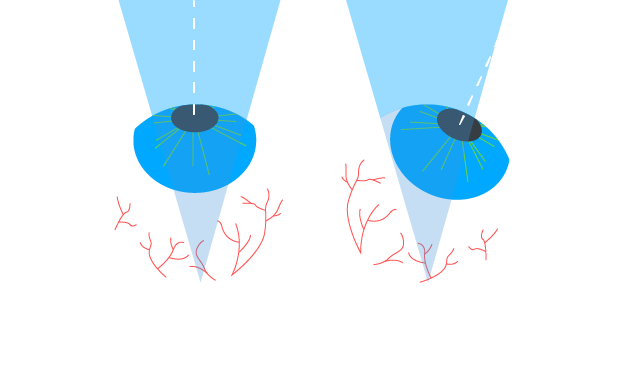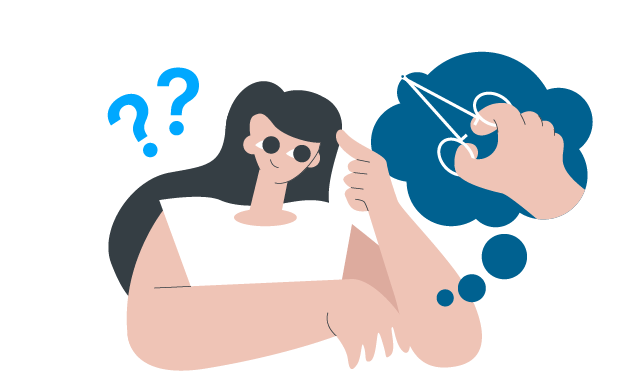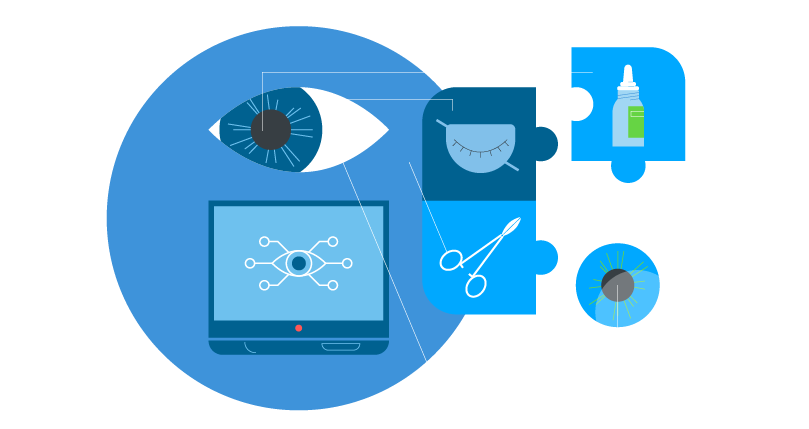As a teenager, I've lost 80% of my left eyesight in 24h.
In the following days, the eye doctor diagnosed me with amblyopia. The official term for a 'lazy eye'. [1]
What I didn't know back then, is that said rapid vision loss is permanent.
What caused said decrease in vision (lazy eye or amblyopia), is less so: Strabismus. [2]
In this article you'll learn the treatment strategies for strabismus (commonly referred to as 'lazy eye'). If you fix a lazy eye early, you might not need to deal with the crippling vision loss I had to develop over time.
Let's dive right in:
1.What is a lazy eye (strabismus)?

Strabismus is the actual situation of the eyes being misaligned. If one eye looks in one direction, and one eye in the other, it's strabismus. [3]
Because well... the eyes are misaligned. Right?
In this article, I'll be using 'strabismus' and 'lazy eye' simultaneously. Because to most of us, they're the same thing. I just wanted to outline that to your doctor, it probably isn't.
1.1 What causes lazy eye?
Again, a person with a lazy eye has misaligned eyes. A lazy eye tends to develop at birth (the child is born too early - as in my case)...
... or it is developed later in life.
The most common cause of a lazy eye is the child being born too early [4] - and due to that, the brain has not learned to use both eyes together properly.
1.2 Can lazy eye turn into blindness (in the weaker eye)?
Lazy eye can not turn into blindness of one eye. It can however, turn into amblyopia. Which is, ironically, the medical term for 'lazy eye'.
Amblyopia means that strabismus can lead to permanent blurred vision in the weaker eye. The severe amblyopia (significant loss of vision) is the worst thing that can happen when you have strabismus (lazy eye).
Because amblyopia can lead to vision impairment due to injury to the strong eye (the one with non-amblyopia), amblyopia is treated as a serious issue. The lifetime risk of impaired vision due to potential injury is 1.2%. [5]
1.3 What are the symptoms of a lazy eye (next to poor vision)?
Next to amblyopia (that causes poor vision), the side effects to having misaligned eyes are:
- Poor depth perception: Which makes it impossible to watch 3d movies. Or makes every day tasks that depend on depth perception, such as parking, more difficult.
- Crossed eyes: Which are socially unpleasant, and makes every day things such a finding a partner more difficult for the patient. As humans have evolved to favor symmetry in their (potential) significant others. [6]
In lazy eye, there is generally a weaker eye - and a stronger eye. The stronger eye (or dominant eye) often dominates the input to the brain. The brain relies completely on the dominant eye, and in doing so, the weaker eye gets left behind.
People with a lazy eye therefore have no binocular vision. The brain relies solely on the stronger eye, which makes binocular vision impossible.
If this gets worse, the nerve signals of the brain to the weaker eye get so small, that the weaker eye inevitably develops blurry vision.
1.4 Is a lazy eye permanent?
Amblyopia (blurry vision) is usually permanent. Strabismus isn't.
Surgery for example is one effective treatment option that shows that strabismus (lazy eye) is anything but permanent. [7] You'll learn more about treatment options later in this article.
For right now, it's suffice to know that strabismus can be treated - and it needs to be dealt with proper treatment for the prevention (or reversal) of amblyopia.
It's important to note though that while some treatment options may improve vision, it's overall significantly less-likely than the proper alignment of the eyes.
1.5 How is lazy eye treated?
Lazy eye is treated by fixing the 'underlying 2-step problem' of misaligned eyes: [8]
- Step 1: The eye do not look in the right direction (needs fixing).
- Step 2: The brain does not process both inputs of the eyes properly (needs fixing as well).
All of the following treatments attack lazy eye at this underlying issue.
1.6 Is it too late to treat lazy eye?
It is never too late to treat a lazy eye. In fact, treatments should be started or continued at any age. Because at any age, amblyopia can get worse!
So while treatment often focuses on children, every adult needs to be concerned about the progression of amblyopia. I can't stress this enough: At any age, one's eye health should be a priority.
2. Treatments for the Causes of Lazy Eye

This article started with the cause, explanation and symptoms of lazy eye.
This was done on purpose, as to understand the treatments for lazy eye, we first have to understand the problem we're trying to solve.
The reality is that lazy eye treatments are plenty. The scope is big. There's almost too many lazy eye treatment options to chose from.
In this part of the article, you'll learn the most common treatments, their pros and cons - and in the end how much they cost.
2.1 Contact lenses
First and foremost, it's important that you correct your weaker eye to the maximum extent that is possible.
Your eyes will only work together properly, if the brain can interpret both images accurately. For that, you need corrective eyewear.
Be that glasses, or corrective lenses. This step should never, ever be ignored. Because of shame, I've refused to wear glasses for a good 1-2 years after my diagnosis. This made my lazy eye worse.
Being introduced to the right prescription lenses made all the difference. I could see more clearly, yet no one could see that I had a problem. What a wonderful concept!
Again, to maximize your chances of treating amblyopia or strabismus, you need the best vision sharpness you can get. Short-term, you can only get this through corrective lenses (prescription lenses) or glasses that correct the refractive errors.
How much does it cost?
Annually, contact lenses cost about $300 to $400. [9] Glasses cost around $242. [10]
2.2 Eye surgery
Strabismus surgery is the most common treatment (some might even argue: the best treatment) of strabismus - and ultimately amblyopia as well.
The surgical treatment involves removal of a tiny part of the eye muscle from the affected eye (often the weaker one) - and following muscle resection (placing it at a different part of the eye). Your eye doctor will often recommend surgery as it's a quick, relatively low risk procedure that offers almost instant benefits.
The eye muscles surgery is a routine procedure: 1.2 million surgeries are done per year. [11]
How much does it cost?
The average total cost of surgery is between $5,000 to $10,000. [12]
2.3 Eye patches
The eye patch is an incredibly useful and simple tool in activating the weaker eye.
By surpressing the dominant eye with an eye patch, the brain is forced to rely more on the weaker eye. Wearing an eye patch is the simplest, most straight-forward way to activate the weaker eye.
The only problem, is that eye patching is often socially unacceptable to a patient. It's awkward, weird - and people can clearly see that something is 'off'. So while eye patches are an effective treatment option, it's often not a preferred one by patients.
How much does it cost?
Eye patches are incredibly cheap. Your eye doctor will charge you a few dollars for them. The downside to eye patching are not cost, but the social awkwardness.
2.4 Eye drops
Medicated eye drops (specifically: atropine eye drops), offer similar benefits to eyepatching. Just without the social shame that goes along with them.
The medicated eye drops effectively blur vision of the dominant eye. In doing so, they force the weaker eye to participate and, ultimately, get stronger.
The only real downside to atropine eye drops is that the sensation is incredibly weird. The affected eye immediately loses a good chunk of vision.
I've relied on my dominant eye my entire life. And when the drops robbed me of my better vision voluntarily the first time, it was a big shock!
How much does it cost?
Eye drops are incredibly cheap as well. Your eye doctor will charge you a few dollars for them. The downside to eye drops are not costs, but the weirdness/lack of productivity throughout the day.
2.5 Vision therapy
While surgery is the quick road towards eye alignment - and therefore, reduction or reversal of amblyopia. Vision therapy is often the long road.
Vision therapy is an effective treatment, but it requires significantly more effort than surgery. The big upside though, is that it entails zero risk.
It's not an invasive procedure, and due to that, it's one of the safest option out there to fix a lazy eye.
How much does it cost?
Not as expensive as surgery, but can range between $500 - $7,000 depending on treatment duration, professionals you work with and equipment needed.
2.6 Eye Exercises
Vision therapy goes hand in hand with lazy eye exercises. When people think about 'exercise', they usually think about joining the gym or going for a run.
This is not what this type of exercise is! These exercises are specifically tailored to your eyes and brain, so ultimately, your brain learns to activate both eyes simultaneously.
One of the most commonly recommended exersises in vision training is the pencil push ups. [13]
How much does it cost?
Free. The downside of exercises are really not the cost, but more the uncertainty and effort required.
2.6 Computer games
Games might be one option that your eye doctor will never speak about. But it's probably also one of the most fun way to improve amblyopia or strabismus (lazy eyes).
Computer games, such as AmblyoPlay, have gained popularity in recent years. So did VR training options such as SeeVividly.
While they are certainly a fun way to improve the condition, often the price tag is still quite steep - and the effort (similar to vision training) is significant.
Games are often a part of vision therapy. Similar to vision therapy, prices range between $500 - $7,000 depending on treatment duration, professionals you work with and equipment needed.
How much does it cost?
Games are often a part of vision therapy. Similar to vision therapy, prices range between $500 - $7,000 depending on treatment duration, professionals you work with and equipment needed.
2.7 Lazyeyefix
A new potential treatment option for adults is our artificial intelligence software Lazyeyefix. Lazyeyefix AI works similar to a computer game, and vision training, just without the prohibitive price tag, significant effort - and lack of tracking that one is moving in the right direction.
Lazyeyefix was created out of frustration. After a failed surgery, and thousands of dollars spend on gadgets and vision training - I decided that I create my own solution.
We're the only lazy eye training option that has a free trial. Our lifetime option costs less than one single consultation at a vision therapy center. But... why don't you see for yourself?
Click here to start a free trial of our Lazyeyefix AI software
How much does it cost?
Our current monthly cost (subject to increase in the future) are $19, $78 for 6 months and $179 for a lifetime membership.
What is the best treatment for lazy eyes?

Having outlined most of the treatments for lazy eyes, one clear question remains: What is the best one?
As one can see above, glasses and lenses are the absolute fundament for proper lazy eye correction. You must correct the refractive error of both your dominant and other eye to have a chance at treating amblyopia.
Then, the treatment options are up to personal preference. I recommend listening to your doctor. Next to that, I'd recommend starting with the most cost-effective options first to test the waters.
References:
[1] The Amblyopia Treatment Studies: Implications for Clinical Practice: https://www.ncbi.nlm.nih.gov/pmc/articles/PMC5396957/
[2] Strabismus by Cleveland Clinic: https://my.clevelandclinic.org/health/diseases/15065-strabismus-crossed-eyes
[3] Strabismus by Cleveland Clinic: https://my.clevelandclinic.org/health/diseases/15065-strabismus-crossed-eyes
[4] Born Too Soon - The Global Action Report on Preterm Birth (WHO): http://apps.who.int/iris/bitstream/handle/10665/44864/9789241503433_eng.pdf?sequence=1
[5] Risk, causes, and outcomes of visual impairment after loss of vision in the non-amblyopic eye: a population-based study: https://pubmed.ncbi.nlm.nih.gov/12241931/
[6] Facial attractiveness: evolutionary based research: https://www.ncbi.nlm.nih.gov/pmc/articles/PMC3130383/
[7] The outcomes of horizontal strab. surgery and influencing factors of the surgical success: https://pubmed.ncbi.nlm.nih.gov/16681059/
[8] How Much Do Contacts Cost?: https://www.cvs.com/optical/article/how-much-do-contacts-cost
[9] How Much Are Eyeglasses Without Insurance?: https://valuvision.com/how-much-are-eyeglasses-without-insurance/
[10] Lazy Eye Surgery Facts: https://www.aao.org/eye-health/tips-prevention/lazy-eye-surgery-facts
[11] The Cost of Strabismus surgery or Correction: https://www.nvisioncenters.com/eye-surgery/strabismus-cost/
[12] The Effectiveness of Home-based Pencil Push-up Therapy Versus Office-based Therapy for the Treatment of Symptomatic Convergence Insufficiency in Young Adults: https://www.ncbi.nlm.nih.gov/pmc/articles/PMC4302485/






